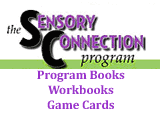About the Author, Karen Moore
 I am an occupational therapist. I have worked in a state hospital for long term psychiatric care as well as on an acute psychiatric unit for adults. I became interested in sensory techniques after studying the work of Lorna Jean King, an occupational therapist who pioneered the use of sensorimotor treatment in psychiatric care. As I became involved in the development and use of sensory groups in the mental health setting I was amazed at the positive responses to this treatment approach. Each time I led or participated in a sensory group I saw what I call mini-miracles. Patients who were barely responsive brightened and became active participants. Patients with symptoms of mania calmed down and became good role models for their peers. By the end of the group patients who were withdrawn as well as those who were unruly and disruptive initially were able to engage in meaningful social interactions with other group members.
I am an occupational therapist. I have worked in a state hospital for long term psychiatric care as well as on an acute psychiatric unit for adults. I became interested in sensory techniques after studying the work of Lorna Jean King, an occupational therapist who pioneered the use of sensorimotor treatment in psychiatric care. As I became involved in the development and use of sensory groups in the mental health setting I was amazed at the positive responses to this treatment approach. Each time I led or participated in a sensory group I saw what I call mini-miracles. Patients who were barely responsive brightened and became active participants. Patients with symptoms of mania calmed down and became good role models for their peers. By the end of the group patients who were withdrawn as well as those who were unruly and disruptive initially were able to engage in meaningful social interactions with other group members.
I became such a convert to this treatment approach that I spent years working on a book that will help other therapists use these sensory strategies in group and individual treatment for adults in the mental health setting. The book is entitled The Sensory Connection Program: Activities for Mental Health Treatment. My understanding on the need for a balanced sensory diet came from the workshops and writings of Patricia Wilbarger. Over the years she became a helpful mentor and I feel honored that she agreed to write the preface to my book.

Karen and Pat Wilbarger
I have become involved in helping mental health programs with restraint reduction initiatives. Sensory strategies can be taught to patients to help them regain control and avoid the need for restraint. These coping strategies empower patients to deal with emotional crisis and stress without relinquishing control to others and without experiencing the humiliating and traumatizing experience of restraints. I have been involved in training staff members at all levels in the use of sensory modalities, sensory issues related to various diagnoses, and safety guidelines. I helped these units develop Sensory Carts or Suitcases to have sensory supplies available to patients and staff members and I am helping them in the development of Sensory Rooms.
My travels throughout the country and Canada providing Sensory Connection Program Trainings have reinforced my commitment to sensory approaches to treatment. The need is even greater for adults and adolescents with mental health problems to be able to self-regulate, control difficult emotions, and find healthy ways to manage stress in an increasingly complex and demanding world. The research that I do before each of these trainings has brought new insights that I decided to share by publishing two more books including a workbook and a new curriculum for self-regulation.
I continue to research and promote the use of sensory related treatment. It is a very effective approach and I feel it is highly underutilized. I'm hoping that through my book and this educational website that others will join in my enthusiasm for sensory activities.
